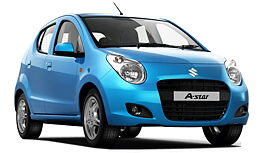Altomatic

On seeing the A-Star, the first thing that comes to mind is the Alto because the A-Star is sold as the Alto in European markets. Alto became Maruti Suzuki India Ltd’s new bread and butter car, a distinction held by Maruti 800, for 25 glorious years. Considering, the Alto is the company’s best-seller, why should Maruti Suzuki discontinue the model? So, when the world got the new Alto, Maruti Suzuki launched it as the A-Star for its Indian buyers.
The A-Star, launched in November 2008, was the first Maruti Suzuki car to be powered with Suzuki’s new generation K-series engine. Apart from being Bharat Stage-IV compliant, Maruti Suzuki also claimed it to be the most fuel-efficient engine- series ever to have been developed by them. The K10B (code name) currently does duty on the A-Star, the new Wagon R, the new Zen Estilo and the recently launched Alto K10. The other K-series engine, the K12M, powers the other two popular cars, the Swift and the Ritz. Maruti Suzuki will soon launch its new A-Star automatic which will power the front wheels through a four-speed automatic transmission.

The A-Star which comes with the same monocoque shell, but a different front and rear end, is sold as the Nissan Pixo in European markets. The Pixo is manufactured in India, at the Maruti Suzuki plant in Manesar and exported to Europe. The Pixo is also powered by the same 1.0-litre KB-series engine and comes with two options: a five-speed manual and four-speed automatic transmission. The A-Star gets the same four-speed transmission from the Nissan Pixo. This makes Maruti Suzuki’s investment almost zero, giving the company the convenience of making yet another variant available for car buyers. The A-Star won’t undergo any cosmetic changes either outside or inside. Also, the automatic transmission will be the only new transmission option available on the A-Star.

The A-Star has been designed in the wind tunnel for better aerodynamic efficiency and the hatchback has a co-efficient of drag of 0.30 which is quiet low thanks to the curvy front end, which has the least co-efficient of drag and this also helps increase the fuel efficiency of the car, as lesser energy is required to cut through the wind. The curved front end with high mounted headlamps and parallelogram-shaped front grille seem to make the front end smile, giving the car its cutesy looks. However, people have different views when it comes to the A-Star’s rear and not too many people find it appealing. The Maruti Suzuki A-Star has scored a three-star rating in the EuroNCAP crash testing, with the A-Star scoring in occupant protection (in the European markets it is sold with airbags) and has received not-so-good ratings in case of a pedestrian impact. The A- star will be available in VXi ABS AT only. A tachometer and airbags are also missing on the car. However, the variant does come with ABS and alloy wheels.
Altomatic (contd..)

The inside of the A-Star automatic seems familiar with the same three-spoke steering wheel, black vents, mounted a tad higher than you’d expect, three-knobs for the air-conditioning and the tachometer mounted separately on top of the instrument cluster. The only thing missing is the golf-ball like gear knob on the manual variant which is replaced with an automatic transmission knob here, on the automatic variant. There is loads of space for the front row passengers, however, it will be a bit of a squeeze for the rear seat passengers. Also, the 129-litre boot space is too small and barely accommodates anything.
The Maruti Suzuki A-Star has a transversely placed 12-valve, three-cylinder 998cc petrol engine that puts out 66bhp and 90Nm of maximum torque at 3500rpm. The K-series engine has a longer stroke length when compared to the older G-series engines which Suzuki used to power the older Alto for the European markets. So the heat losses of the engine are lesser (scientifically it can be said that the engine has a greater thermal efficiency) and this results in better fuel efficiency. The hatchback should clock the 100kph mark in about 20 seconds. The four-speed automatic is the conventional epicyclic-type of transmission. The gear shifts are a bit sluggish if you compare it to the modern quick-shifting gearboxes, and in the end it is the price that matters. ARAI claims the A-Star to have a mileage of 17kpl.

The A-Star sports the McPherson struts with a good rigidity suspension frame at its front and it has an isolated trailing link at its rear. With no change in the suspension system, the A-Star’s ride and handling remain the same.The ride is a bit stiff and handling good enough if driven within city speed limits. The light steering wheel along with the automatic transmission reduces driver fatigue especially in bumper-to-bumper city traffic. The A-Star has a turning radius of 4.5m which in turn makes U-turns and parking in tighter slots effortless.

The A-Star Automatic, priced at about Rs 4.5lakhs (ex-showroom, Delhi), should be a good option if especially for those who wish to use it for city commute. Being a Maruti Suzuki, you won’t need to worry about issues such as aftersales and resale value, however, if there are more than two people commuting longer distances, it can get a bit tiresome for the back seat occupants. The only competition that the Maruti Suzuki A-Star automatic has is the Hyundai i10 automatic which Hyundai has priced well. The cheapest automatic transmission, the Hyundai i10, costs Rs 4.74 (ex-showroom, Mumbai) and comes with a more powerful 80bhp 1.2-litrepetrol engine and more rear seat space. However, now, the Hyundai i10 is a comparatively older design than the Maruti Suzuki A-Star, which is fresher, both, in the market as well as in people’s minds. This should be the new obvious Altomatic choice for the automatic generation.
























